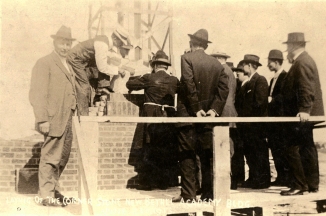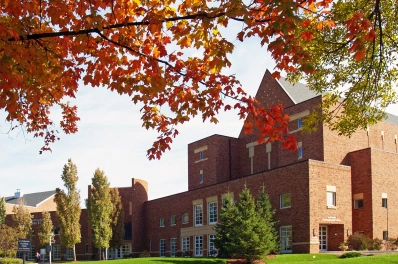
June 21, 1915: Laying the cornerstone of Bethel Academy’s new building – Courtesy of Bethel University Digital Library
The year 2014 marked the 100th anniversary of the beginning of World War I, one of the most devastating events in human history.
Much less famously, 1914 was also the year that the Swedish Baptist Theological Seminary moved from Chicago, Illinois to St. Paul, Minnesota, where it merged with — and took the name of — a Christian high school called Bethel Academy.
That fall the battlefields of Europe must have seemed impossibly far away to the teachers and students starting classes on a quiet campus nestled in the middle of neutral America. But only three years later, some of them would be in the military, readying to play their part in the Great War, and Bethel’s campus would host Red Cross workers and Liberty Loan drives, its athletic field dug up for a potato garden.
❧
In the century separating 1914 and 2014, warfare has become a totalizing experience — not confined to relatively small groups of professional soldiers fighting to relatively clear conclusions on clearly demarcated battlefields, but a phenomenon that has lingering repercussions for politics, economics, culture, and, yes, religion and education. In the same century Bethel has developed into a master’s level university, with war sometimes fueling growth and ambition, other times threatening demise and division, and always forcing those who fought and those who stayed home to wrestle with its implications for how they lived and what they believed.
To help the people of Bethel — and any others interested in the intersection of war, education, and religion — understand Bethel’s experience of that century of war, we present this digital history project: Bethel at War, 1914-2014.
We mean it to be an impressionistic survey focused on four modern conflicts: World War I, World War II, the Vietnam War, and the War on Terror. For each, we’re trying to address the following questions:
- How did people from Bethel participate in the war?
- How did the war shape life at Bethel itself?
- During each conflict, how did people at Bethel understand and respond to the sometimes competing demands of national solidarity and Christian commitment?
There are multiple ways to engage with the site. There’s a traditionally linear Narrative composed of long-form interpretive essays taking you war-by-war through our century-long story. You can also explore via the Timeline and Map interface or by going back through our Project Blog.
About Us
Chris Gehrz is professor of history and chair of the History Department at Bethel University. For Bethel at War he took responsibility for coverage of the two World Wars.
Fletcher Warren graduated from Bethel University in May 2015 with majors in History and Business & Political Science and presently works as a legal researcher. He focused on Bethel’s experience of the Vietnam War and the War on Terror for this project.
Acknowledgments
A project of this scale is possible only with the assistance and encouragement of many people, too many to name here. But we want to specially thank the following:
Deb Sullivan-Trainor and the members of the Edgren Scholars Committee made possible our research in the summer of 2014. As Bethel’s archivist and digital library manager, respectively, Diana Magnuson and Kent Gerber make research into Bethel history a genuine pleasure. Diana is also one of the many historians on whose work we build when we attempt to interpret the history of Bethel University — others include G.W. Carlson and the late Adolf Olson, Virgil Olson, and Norris Magnuson. (GW also supplied helpful documents from his own personal collection.)
Our librarians at Bethel helped us fill seemingly countless interlibrary loan requests, and the libraries and archives of the University of Minnesota, University of St. Thomas, University of Washington, Calvin College, and the Museum of History & Industry were kind enough to grant permission for us to reproduce images. Curt Hanson at the University of North Dakota helped us track down an oral history interview with Rodney Kephart (JC ’40), who spent World War II in Japanese POW camps. Fellow historian and Asbury professor David Swartz was kind enough to offer helpful bibliographic direction.
Finally, we would like to thank our families, without whose unflagging support this project would not have been possible.


